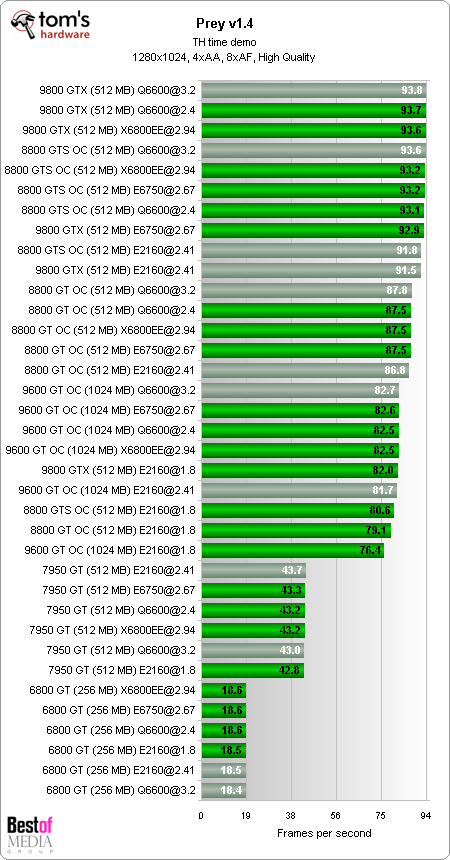GPU vs. CPU Upgrade: Extensive Tests
Features
By
Tino Kreiss
published
Add us as a preferred source on Google
Prey v1.4
Without antialiasing, the Geforce 6800 GT is able to produce fluid animations on screen at up to at least 1680x1050 pixels, but it does not respond to increased CPU performance. The Geforce 7950 GT copes well with increased resolutions and antialiasing, but also does not respond to improved CPU performance. The 1800 MHz from E2160 is sufficient to produce fluid frame rates with the Geforce 8 and 9; at the 2410 and 2670 MHz CPU clock rates, the new cards are able to provide considerably more 3D speed. Overclocking the Q6600 only has an effect at the 1280x1024 pixel resolution without antialiasing.






Stay On the Cutting Edge: Get the Tom's Hardware Newsletter
Get Tom's Hardware's best news and in-depth reviews, straight to your inbox.
Current page: Prey v1.4
Prev Page Microsoft Flight Simulator X SP2 Next Page World in Conflict v1.05
75 Comments
Comment from the forums
-
randomizer That would simply consume more time without really proving much. I think sticking with a single manufacturer is fine, because you see the generation differences of cards and the performance gains compared to geting a new processor. You will see the same thing with ATI cards. Pop in an X800 and watch it crumble in the wake of a HD3870. There is no need to inlude ATI cards for the sake of this article.Reply -
randomizer This has been a long needed article IMO. Now we can post links instead of coming up with simple explanations :DReply -
yadge I didn't realize the new gpus were actually that powerful. According to Toms charts, there is no gpu that can give me double the performance over my x1950 pro. But here, the 9600gt was getting 3 times the frames as the 7950gt(which is better than mine) on Call of Duty 4.Reply
Maybe there's something wrong with the charts. I don't know. But this makes me even more excited for when I upgrade in the near future. -
This article is biased from the beginning by using a reference graphics card from 2004 (6800GT) to a reference CPU from 2007 (E2140).Reply
Go back and use a Pentium 4 Prescott (2004) and then the basis of these percentage values on page 3 will actually mean something. -
randomizer yadgeI didn't realize the new gpus were actually that powerful. According to Toms charts, there is no gpu that can give me double the performance over my x1950 pro. But here, the 9600gt was getting 3 times the frames as the 7950gt(which is better than mine) on Call of Duty 4. Maybe there's something wrong with the charts. I don't know. But this makes me even more excited for when I upgrade in the near future.I upgraded my X1950 pro to a 9600GT. It was a fantastic upgrade.Reply -
wh3resmycar scyThis article is biased from the beginning by using a reference graphics card from 2004 (6800GT) to a reference CPU from 2007 (E2140).Reply
maybe it is. but its relevant especially with those people who are stuck with those prescotts/6800gt. this article reveals an upgrade path nonetheless -
randomizer If they had used P4s there would be o many variables in this article that there would be no direction and that would make it pointless.Reply -
JAYDEEJOHN Great article!!! It clears up many things. It finally shows proof that the best upgrade a gamer can make is a newer card. About the P4's, just take the clock rate and cut it in half, then compare (ok add 10%) hehehReply -
justjc I know randomizer thinks we would get the same results, but would it be possible to see just a small article showing if the same result is true for AMD processors and ATi graphics.Reply
Firstly we know that ATi and nVidia graphics doesn't calculate graphics in the same way, who knows perhaps an ATi card requiers more or less processorpower to work at full load, and if you look at Can you run it? for Crysis(only one I recall using) you will see the minimum needed AMD processor is slover than the minimum needed Core2, even in processor speed.
So any chance of a small, or full scale, article throwing some ATi and AMD power into the mix?
